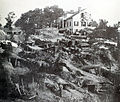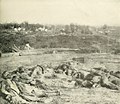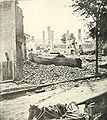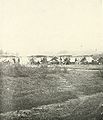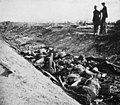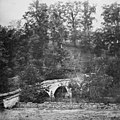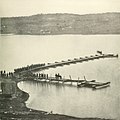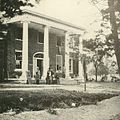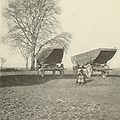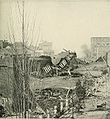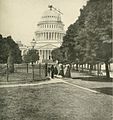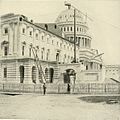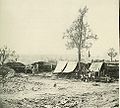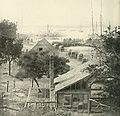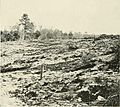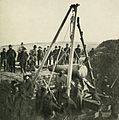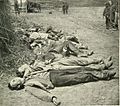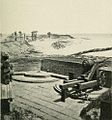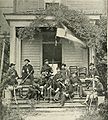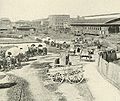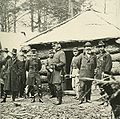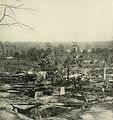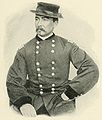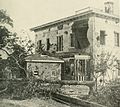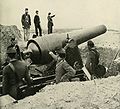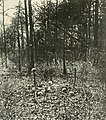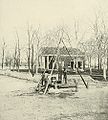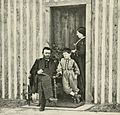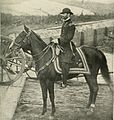-
Confederate General Lewis A. Armistead vignette
-
Confederate General George S. Pickett
-
Confederate General Robert E. Lee
-
Confederate General Sterling Price (photographed in his U.S. uniform before the war)
-
Confederate General Earl Van Dorn
-
Union Brigadier General George W. Taylor
-
"Quaker guns" made of pine logs were mounted in a ruse to fool the Union into believing that the Confederates were much better armed at Port Hudson, 1863. Black rings were painted on the end of the logs to make the muzzles look convincing. It worked. After Farragut's two vessels passed by Port Hudson, the union chose to never attack from the river again.
-
Confederate siege gun mounted in the river fortifications at Port Hudson, 1863.
-
The front of Shirley's House, also known as the White House, during the siege of Vicksburg, 1863.
-
Shirley's House, also known as the White House, during the siege of Vicksburg, 1863. Union troops of Logan's division set about as engineers and sappers to undermine Confederate fortifications but they had to stay under cover for fear of Confederate sharpshooters.
-
Battery Sherman on the Jackson Road outside of Vicksburg, 1863.
-
"Whistling Dick" was the name given to this specific Confederate 18 pounder because of the peculiar noise made by its projectiles. It was part of the defensive batteries facing the Mississippi River at Vicksburg. On May 28 1863, its fire sank the USS Cincinnati.
-
USS Choctaw lies anchored after the Siege of Vicksburg.
-
Confederate dead lay gathered at the bottom of the parapet of Battery Robinett on the day after the Battle of Corinth. Col. William P. Rogers of the 2nd Texas (on the very left) seized his colors to keep them from falling again and jumped a five foot ditch, leaving his dying horse and assaulted the ramparts of the battery. When canister shot killed him, he was the fifth color bearer to fall that day. Note: This text erroneously reports that his second-in-command, Col. Lawrence Ross lays beside him. In fact, Ross went on to become a general and later the governor of Texas. He died in 1898.
-
These homes near the southeastern flank of the arsenal at Baton Rouge were ordered destroyed by Union Colonel Halbert E. Paine after the surprise Confederate attack on August 5, 1862 so that they would not afford shelter to any potential attackers. The Union would abandon Baton Rouge without being attacked again. Instead they headed to New Orleans under the orders of General Butler.
-
Union Camp Banks, temporary home to the 7th Vermont, 21st Indiana and Nims' Battery in Baton Rouge was photographed in late July 1862. During the Confederate surprise attack of August 5, this camp became a battlefield. Union troops in the hospital grabbed their weapons and helped repulse the Confederates.
-
Union troops of the 2nd Brigade under the command of General Thomas Williams have encamped in the city limits of Baton Rouge. This photo was taken shortly before August 5, 1862. On that morning, Confederate General John C. Breckinridge's two divisions took advantage of a dense fog and made a surprise attack. Initially, they were successful in taking much of the Union camp but would eventually be repulsed. General Williams, however, lay dead on the battlefield. Photo 1 of 2.
-
Union troops of the 2nd Brigade under the command of General Thomas Williams have encamped in the city limits of Baton Rouge. This photo was taken shortly before August 5, 1862. On that morning, Confederate General John C. Breckinridge's two divisions took advantage of a dense fog and made a surprise attack. Initially, they were successful in taking much of the Union camp but would eventually be repulsed. General Williams, however, lay dead on the battlefield. Photo 2 of 2.
-
The Dunker Church to the north of Sharpsburg, Maryland marks where one of the bloodiest battles in American history would begin at dawn on September 17, 1862. Here, both Union and Confederate dead lay together on the field.
-
The Lutheran Church just east of Sharpsburg marks the extent of the Union offensive during the Battle of Antietam, 1862. Union skirmishers moved to the cross-street just beyond the church as a Confederate Corps commanded by A.P. Hill arrived on the Shepherdstown Rd., surprising Burnside's troops and driving them back.
-
"Bloody Lane" in the sunken road after the Battle of Antietam, 1862. General A. P. Hill's Confederate troops received multiple assaults and an enfilading fire from several Union divisions leaving this bloody scene.
-
Burnside's bridge just after the Battle of Antietam, 1862.
-
Aquia Creek Landing in Union control in February 1863. This position swapped hands between the two armies during 1861-1862 until the Union established a logistical supply point here for the Army of the Potomac.
-
Union General Ambrose Burnside, 1862.
-
Western view from Fredericksburg down Telegraph Road with Marye's Heights visible in the distant center. Several Union divisions would march down this road during the Battle of Fredericksburg to assault the Confederate positions on the heights unsuccessfully. Eventually, they would retreat back down this road after being decimated.
-
View of Fredericksburg from the east of the Rappahannock River, 1862.
-
Chancellor House was the headquarters of General Joseph Hooker during the Battle of Chancellorsville, 1863. The general was knocked off his feet with a possible concussion when a Confederate artillery round smashed into a column that he was standing beside. Later, the general would take flight leaving the house to fall prey to heavy Confederate fire.
-
Dowdall's Tavern was Union General Oliver O. Howard's headquarters until he was surprised and driven by Stonewall Jackson's Confederate troops at the Battle of Chancellorsville, 1863.
-
Wilderness Church at Chancellorsville was the center of a stand made by Union general Schurz's division after Confederates under Stonewall Jackson made a surprise flank attack. The stand was brief as the Confederates smashed through and continued to roll up the Eleventh Corps (under command of General Oliver O. Howard).
-
Union General George Stoneman & staff, 1863.
-
Union General Joseph Hooker (seated 2nd to right) and his staff, 1863.
-
General "Fightin' Joe" Hooker
-
150th Pennsylvania Infantry maneuvering approximately 3 weeks before the Battle of Chancellorsville, 1863.
-
Burnside's headquarters at Phillips' House during the Battle of Fredericksburg. It was here that his staff generals dissuaded him from carrying on any more assaults.
-
Marye's House upon Marye's Heights was the center of the Confederate position during the Battle of Fredericksburg, 1862. Confederate troop encampments are visible to the right.
-
Union engineers built the pontoon bridges at Franklin Crossing where Gen. Franklin spent two days crossing with the left wing of the Union army for the Battle of Fredericksburg.
-
House in Fredericksburg destroyed by Union artillery in December 1862.
-
View of Stafford Heights across the Rappahannock River from Fredericksburg from Confederate-built trenches used during the Battle of Fredericksburg in 1862. Union army encampments are seen on the heights and a pontoon bridge is seen further down river from the destroyed bridge.
-
Limbered Union artillery behind their redoubts across the Rappahannock River from Fredericksburg in 1863
-
Union army pontoon boats mobilized for deployment
-
-
-
-
-
-
-
-
-
-
Atlanta Rail Depot destroyed in 1864.
-
Outside Fort Johnson at Charleston with Fort Sumter in the distance.
-
Confederate gun at Battery Dantzler, Drewry's Bluff.
-
Photo taken from General Warren's headquarters at Beverly House of Union artillery massing for an advance.
-
Confederate Camp Washington (Battery Washington) near Sullivan's Inlet at Charleston.
-
The Capitol Building in Washington D.C. is nearly complete in this photograph taken just a few days after the Battle of Gettysburg.
-
Photo of the Capitol Building in Washington D.C. taken during the American Civil War.
-
This Confederate redoubt guarding Taylor's Bridge was captured by Union troops of Hancock's Corps on May 23 1864.
-
The Chain Bridge guarded by a Union pickett was one of the ways to cross the Potomac into Washington.
-
Taylor's Bridge, also known as the Chesterfield Bridge, where the Telegraph Road crosses the North Anna River. The 93rd New York Infantry seized the bridge under fire before the Confederates could destroy it.
-
City Point at the juncture of the Appomattox and James Rivers after its capture by General Benjamin Butler. This served as the primary logistics point for the Union army during its siege of Petersburg and Richmond from June 1864 -
-
Chambersburg Pennsylvania in ruins after Confederates under General McCausland reciprocated against the Union for their destruction during Hunter's raid in the Shenandoah Valley.
-
Chambersburg Pennsylvania was destroyed by McCausland's Confederate cavalry in July 1864.
-
The Battle of Cold Harbor took place here on July 3 1864.
-
Makeshift Confederate breastworks at the extreme left of their line thrown up at the Battle of Cold Harbor, July 3 1864.
-
View of Columbia, South Carolina in ruins taken from the destroyed capitol building in 1865.
-
Ruins of the unfinished capitol building in Columbia, South Carolina.
-
The massive crater at Petersburg made by an explosion from underneath Confederate entrenchments on July 30 1864.
-
Confederate General John B. Hood ordered this destruction of railway and rolling stock in Atlanta to prevent resources from falling into the hands of Sherman's Union troops.
-
Union dead from the Battle of the Wilderness and the Battle of Spotsylvania being buried at Fredericksburg.
-
Locomotives were massed within the defense lines of Washington DC to prevent them from falling into Confederate hands. The newly-finished Capitol Building is visible in the distance.
-
One of the Union siege guns mounted in defense of Washington.
-
The "Dictator" siege mortar at Petersburg
-
The Dictator at Petersburg on its rolling platform.
-
Union troops under General William B. Hazen work at dismantling Confederate Fort McAllister north of Savannah, Georgia. Here they are removing a 48 pounder, 8 inch Colombiad.
-
Confederate dead of General Ewell's Corps who attacked the Union lines at the Battle of Spotsylvania.
-
This unidentified, dead Confederate soldier of Ewell's Corp was killed during their attack at Allsop's Farm during the Battle of Spotsylvania. His right knee had been shattered and he had bandaged it but a later wound tearing his left shoulder apart caused him to bleed to death.
-
Inside Confederate Fort Moultrie (Sullivan's Island) looking east of Charleston Harbor.
-
Fort Stevens (formerly Fort Massachusetts) near the summer home of Abraham Lincoln. On July 12, 1864 Lincoln was standing on the ramparts of this fort when the surgeon standing beside him was wounded in the leg by a Confederate sharpshooter.
-
Union calvary general Alfred T. A. Torbert (seated center holding saber in front of him) and staff at their headquarters during the Shenandoah Valley campaign under Sheridan in 1864.
-
Union General US Grant smokes with his back to the smaller tree as he makes the decision with his council to "fight it out". The decision was a costly one as it lead to the Union defeat at the Battle of Cold Harbor and more than 10,000 Union dead.
-
Confederate General John Bell Hood
-
Confederate General Jubal S. Early
-
Confederate position at the Battle of Kennesaw Mountain.
-
Civilians of Atlanta scramble to board the last train to leave under the mandatory evacuation order given by General William T. Sherman. Many wagons and belongings had to be abandoned.
-
General Sherman's mandatory evacuation order in September 1864 led to this photograph of the last train leaving Atlanta. With overloaded cars, it will not have enough room for civilians to bring all of their belongings which can be seen littered beside the tracks beside the wagons they leave behind.
-
Union General George Gordon Meade (center) and staff. This photo is approximately two months before General John Sedgewick (2nd from right in rounded hat) was killed at the Battle of Spotsylvania on May 9, 1864.
-
Interior view of the Union's "Moving" battery at the Siege of Petersburg, 1864.
-
Sherman's Union troops occupy Confederate Fort D near Peachtree Street, Atlanta 1864. Photo 1 of 2. Complement photo is
File:PeachtreeBatteryAtlanta1864crop01.jpg
-
Sherman's Union troops occupy Confederate Fort D near Peachtree Street, Atlanta 1864. Photo 2 of 2. Complement photo is
File:PeachtreeBatteryAtlanta1864crop02.jpg
-
Union graves close to where the soldiers fell after the Confederates under John B. Hood attacked at Peachtree Creek just north of Alanta, 1864.
-
Union General Phillip H. Sheridan
-
Potter's House in Atlanta housed Confederate sharpshooters until Union artillery made a special target of it.
-
Confederate earthworks overlooking the battlefield at Resaca, 1864.
-
Confederate General-in-Chief Robert E. Lee photographed in 1865.
-
"Remains of the Circular Church and 'Secession Hall' where South Carolina decided to leave the Union".
-
General Hazen's men of the Fifteenth Corps man a captured Confederate siege gun at Fort McAllister for the camera. Standing at attention above and facing the weapon is a U.S. Marine and beside him leaning on his saber is a cavalryman.
-
The Union's Moving Battery armed with a siege mortar on the City Point Railroad during the Siege of Petersburg.
-
Skulls remaining on the field and trees destroyed at the Battle of the Wilderness, 1864.
-
Spotsylvania Courthouse, 1864.
-
Union artillery and infantry cross the Chattahochee River in a canvas pontoon boat.
-
"Federal entrenchments at the foot of Kenesaw Mountain."
-
"General Ulysses S. Grant at City Point in 1864 with his wife and son Jesse."
-
General-in-Chief of the Union Army, Ulysses S. Grant in 1865.
-
Union General William T. Sherman
-
Union General William T. Sherman (standing with arm on the breech of the weapon) and staff.
-
The ruins of the Virginia Military Institute after Hunter's Raid in 1864.
-
"Charleston's Famous Zouave Cadets drilling at Castle Pinckney."

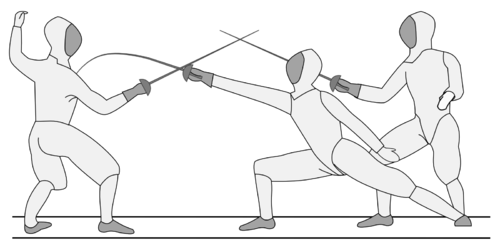

![]() My handle has nothing to do with any organizations that use the term "Berean". Instead, it is philosophically about the diligence of looking things up and the enjoyment that comes from discovery....
My handle has nothing to do with any organizations that use the term "Berean". Instead, it is philosophically about the diligence of looking things up and the enjoyment that comes from discovery....





































